#Eli Escusido
Explore tagged Tumblr posts
Text
Child finds a 100-year-old cross medallion in Jerusalem’s Ein Karem Neighborhood
Child finds a 100-year-old cross medallion in Jerusalem’s Ein Karem Neighborhood
Redazione Ten year old Nehorai Nir recently went on a class trip to picturesque Ein Karem in Jerusalem as a student in Jerusalem’s Argentina Experimental High School in Kiryat Hayovel. “We were picking edible plants, and I was surprised to see on the slope below me on a beautiful red pomegranate lying there on the ground,” Nir recounts. “I ran to pick it up and discovered a worm inside, so I…
#Amit Re’em#archaeology#Ein Karem#Eli Escusido#English news#Israel#Israel Antiquities Authority#Jerusalem
0 notes
Text
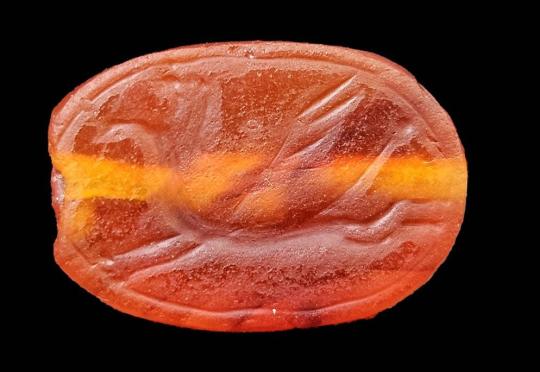
A Rare 2,800-Year-Old Scarab Amulet Found in Israel
Antiquities Authority says recent winter rains helped expose buried antiquities, urges public to be aware and to turn over finds.
A rare scarab amulet from the First Temple period was recently discovered by a hiker in the Nahal Tabor Nature Reserve in the Lower Galilee and turned over to the Israel Antiquities Authority (IAA).
The scarab, made from reddish-brown carnelian stone, is estimated to be 2,800 years old and of Assyrian or Babylonian origin. The front is carved in the shape of a beetle, and the back has engravings that depict a griffon or a winged horse, a common motif of the Ancient Near East.
When he discovered the artifact, Erez Avrahamov, 45, was on a two-day leave from IDF reserve duty, taking advantage of a sunny day after recent rains.
“I saw something shimmering on the ground. At first, I thought it was a bead or an orange stone. After I picked it up, I realized it had engravings resembling a beetle. I called and reported the amazing find to the Antiquities Authority,” Avrahamov said, according to a Wednesday IAA press release.
Abrahamov found the scarab near the bottom of Tel Rekhesh, associated with the city of Anaharath mentioned in the Book of Joshua.
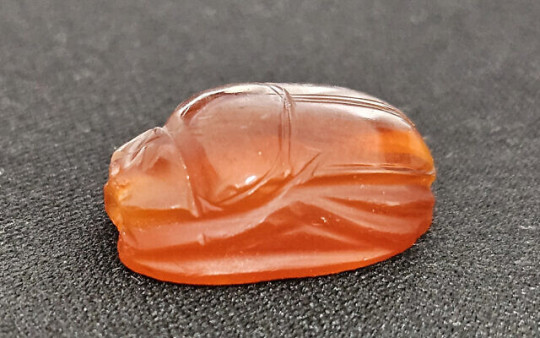


During the 6th-7th centuries BCE, “a large citadel stood at the top of the mount, where bathing facilities, halls and ritual chambers were found from the period of Assyrian rule. This rule, as we know, was responsible for the destruction of the Kingdom of Israel” in the First Temple period, IAA archaeologist Dr. Yitzhak Paz explained.
The scarab is likely from this period of Assyrian control and “may indicate the presence of Assyrian (or perhaps Babylonian) officials at Tel Rekhesh during this period,” Paz added. If the scarab can be conclusively dated and this connection proven, it will be a discovery of “great significance,” he said.
Scarab seals of a similar type, fashioned into a dung-beetle shape from a wide variety of stones, originated from Pharaonic Egyptian culture but were widely used throughout the ancient world.
The orange color and material of the scarab found by Abrahamov are fairly rare, the IAA said, as most were made from a softer bluish stone and then covered in glaze, which in almost all cases has worn away with time.
The IAA said it’s likely that the recent rains uncovered the scarab. “As in every winter, when the rainy season arrives, antiquities start to ‘float’ and rise to the surface,” IAA Director Eli Escusido said.
“I am imploring the public to obey the Antiquities Law, and request that if you come across an archaeological find, report it to the Antiquities Authority while in the field. The exact location where an object is found is extremely important… The special scarab will be stored in the state archive, where we can research and learn more about it,” he said.
Under Israeli law, any found man-made object dating from before 1700 is to be turned over to the authorities. Abrahamov received a good citizenship certificate for doing so.
By GAVRIEL FISKE.

#A Rare 2800-Year-Old Scarab Amulet Found in Israel#Nahal Tabor Nature Reserve#First Temple period#carnelian stone#ancient artifacts#archeology#archeolgst#history#history news#ancient history#ancient culture#ancient civilizations#art#ancient art
243 notes
·
View notes
Text
Scoperte / “Per sempre custodiremo l’eterna primavera”: trovata a Gerusalemme la più antica iscrizione cinese d'Israele, ha 500 anni
ARCHEOLOGIA | Scoperte / “Per sempre custodiremo l’eterna primavera”: trovata a Gerusalemme la più antica iscrizione cinese d'Israele, ha 500 anni
Elena Percivaldi Un frammento di ciotola in porcellana, risalente al XVI secolo e appartenente alla dinastia Ming, è stato scoperto sul Monte Sion a Gerusalemme: si tratta della prima prova archeologica di un legame diretto tra la Terra d’Israele e la Cina. La scoperta e la sua importanza Il reperto è emerso durante uno scavo congiunto condotto dall’Israel Antiquities Authority e dal…
#archeologia#Cina#dinastia Ming#Eli Escusido#Estremo Oriente#Gerusalemme#Israel Antiquities Authority#Israele#Jingchao Chen#notizie#Protestant Institute of Archaeology#scavi#scavi archeologici#scoperte#Università Ebraica di Gerusalemme#Vicino Oriente
0 notes
Text
Monumental fortifications from biblical Jerusalem discovered out of the City of David [VIDEO]
Monumental fortifications from biblical Jerusalem discovered out of the City of David [VIDEO]
Who divided Jerusalem into two? A massive fortification discovered in the Givati Parking Lot excavations at the City of David in the Jerusalem Walls National Park solves a 150-year-old mystery. Created by extensive quarrying, the moat formed a massive channel separating the City of David from the Temple Mount and the Ophel area. Perpendicular cliffs on both sides of the moat rendered it…
#archaeology#discoveries#Eli Escusido#English news#excavations#fortification#Israel Antiquities Authority#Jerusalem#Tel Aviv University
0 notes
Text
Perfectly preserved 2,300-year-old gold ring of a child found in the City of David
Perfectly preserved 2,300-year-old gold ring of a child found in the City of David
Redazione A gold ring set with a precious stone dating from the early Hellenistic period was recently found in the joint Israel Antiquities Authority-Tel Aviv University excavation in the City of David, part of the Jerusalem Walls National Park, with the support of the Elad Foundation. The find will be exhibited to the public in the free “Jerusalem Mysteries” conference hosted by the Israel…

View On WordPress
#archaeology#archeologia#Eli Escusido#English news#Gerusalemme#Israel#Israel Antiquities Authority#Israele#Jerusalem#Jerusalem Walls National Park#Marion Zindel#notizie#Riki Zalut Har-tov#scavi archeologici#Tehiya Gangate#Yiftah Shalev
0 notes
Text
Byzantine-period church with wall art displaying 1500-year-old ships revealed in the Northern Negev, Gaza [VIDEO]
Church Walls Revealed by Excavations Portray 1500-year-old Ships in Northern Negev, Gaza [VIDEO]
A Byzantine-period church with wall art displaying ships was found in Israel Antiquities Authority excavation in the Northern Negev. The discovery was made to the south of Rahat in the context of a city expansion project to add a new neighborhood for Bedouin city and suburban residents, funded by the Authority for Development and Settlement of the Bedouin in the Negev. The Israel Antiquities…

View On WordPress
#archaeology#Byzantine period#Deborah Cvikel#Elena Kogan-Zehavi#Eli Escusido#English news#Gaza#Israel#Israel Antiquities Authority#Israele#Negev#Noé David Michael#ships#University of Haifa
0 notes
Text
Impressive Hiding Complex from the period of the Bar Kokhba Revolt revealed near the Sea of Galilee [VIDEO]
Impressive Hiding Complex from the period of the Bar Kokhba Revolt revealed near the Sea of Galilee [VIDEO]
Archaeological excavations at Huqoq near the Sea of Galilee, in which students, local residents and soldiers participated over the past few months, provide a glance at dramatic episodes in the history of the Jewish people: the preparation of shelters in preparation for the Revolt of the Jews against the Romans, led by Bar Kokhba in 132–136 CE. 1.Huqoq site, aerial view. Photograph Emil Aladjem,…

View On WordPress
#archaeology#archeologia#archeonews#Bar Kokhba#discoveries#Einat Ambar-Armon#Eli Escusido#English news#excavations#Huqoq#Israel#Israel Antiquities Authority#Israele#North Carolina University#rivolta di Bar Kokhba#scavi#scavi archeologici#scoperte#Uri Berger#Yinon Shivtiel#Zefat Academic College
0 notes
Text
ARCHAEONEWS / 1,800 year-old oil lamp used by Roman soldiers discovered by a pupil on a school trip in southern Israel
ARCHAEONEWS / 1,800 year-old oil lamp used by Roman soldiers discovered by a pupil on a school trip in southern Israel
Sixteen year-old Yonatan Frankel, a pupil from the Tamar High School in Hod Hasharon, was with his class on an annual field trip along the Scorpions Ascent in southern Israel. When his class stopped for lunch next to the Late Roman fort of Mezad Tzafir, Yonatan began to pick up rocks from the sand to look at them. “One of the stones that I picked up was full of dirt. I shook it off, and suddenly…
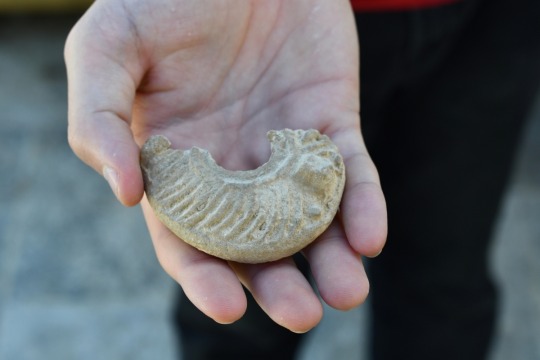
View On WordPress
#archeologia#archeonews#discoveries#Eli Escusido#English news#età romana#excavations#Israel#Israel Antiquities Authority#Israele#Late Roman fort of Mezad Tzafir#Mezad Tsafir#Roman lamp#scavi#scoperte#Scorpions Ascent
0 notes
Text
Rare coin from the time of the Bar Kokhba Revolt discovered in the Judean Desert
Rare coin from the time of the Bar Kokhba Revolt discovered in the Judean Desert
A rare coin from the time of the Bar Kokhba Revolt, bearing the name of “Eleazar the Priest”, and dated to the first year of the revolt (132 CE), was discovered in the Mazuq Ha-he’teqim Nature Reserve. The coin was discovered together with three other coins from the time of the Revolt, bearing the name “Simeon��. The coin was discovered in the course of the Judean Desert Cave Survey carried out…

View On WordPress
#archaeology#Bar Kokhba#coins#Eli Escusido#English news#excavations#Giudean Desert#Israel Antiquities Authority
0 notes
Text
ARCHEOLOGIA / Dagli scavi nel deserto della Giudea riemerge una rara moneta dell'epoca della rivolta di Bar Kokhba [FOTO / VIDEO]
#ARCHEOLOGIA / Dagli scavi nel deserto della Giudea riemerge una rara moneta dell'epoca della rivolta di Bar Kokhba [FOTO / VIDEO] Il ritrovamento durante le operazioni condotte dall'IAA per recuperare i reperti prima che cadano in mani ai tombaroli.
Una rara moneta risalente al periodo della rivolta di Bar Kokhba, recante il nome di un certo “Eleazar il Sacerdote” e datata al primo anno della rivolta stessa (132 d.C.), è stata scoperta in Giudea nella Riserva Naturale di Mazuq Ha-he’ teqim. La moneta era insieme ad altre tre coeve recanti il nome “Simeon”. La scoperta è avvenuta nel corso del progetto “Judean Desert Cave Survey”, condotto…

View On WordPress
#archeologia#Bar Kokhba#Eli Escusido#Giudea#Israel Antiquities Authority#monete#numismatica#scavi#scavi archeologici
0 notes
Photo






1,800-Year-Old Gold Jewelry Discovered in Jerusalem Burial Cave
This glimmering collection of ancient gold jewelry was found in an ancient burial cave near Jerusalem. Decorated with the symbol of the Roman goddess Luna, the 1,800-year-old jewelry was intended to ward off evil spirits and provide protection for a young girl in the afterlife.
The beautiful objects were first discovered over 50 years ago, but the results of the excavation were never published. Now, they will be exhibited to the public for the first time at the 48th Archaeological Congress in Jerusalem, organized by the Israel Antiquities Authority, the Israel Exploration Society, and the Israel Archaeological Association.
The lot includes gold earrings, a hairpin, a gold pendant, gold beads, carnelian beads, and a glass bead.
They were first found in 1971 inside a lead coffin at a Roman-era burial site on Mount Scopus, a mountain in northeast Jerusalem. It appears the fine objects were either placed alongside the remains of a young girl by her relatives or she was simply buried wearing the jewelry.
“The interring of the jewelry together with the young girl is touching. One can imagine that their parents or relatives parted from the girl, either adorned with the jewelry, or possibly lying by her side, and thinking of the protection that the jewelry provided in the world to come. This is a very human situation, and all can identify with the need to protect one’s offspring, whatever the culture or the period,” Eli Escusido, Director of the Israel Antiquities Authority, said in a statement seen by IFLScience.
The jewelry is a snapshot in time of an era when this part of the world was ruled over by the Roman Empire. For a little over a century, between 6 CE and 132 CE, this area was known as the Roman province in Judea. It's notably the period that saw the life of Jesus, as well his crucifixion, and the emergence of Christianity.
While Roman rule had a bloody and turbulent end, the culture left its influence, as evidenced by this jewelry. Some of the relics – such as the chain with a lunula pendant (pictured below) – feature the symbols of Luna, the Roman moon goddess who was often portrayed as the female counterpart of Sol, the Roman personification of the Sun.
The historical setting of the burial indicates that this might have been the burial site of newcomers to the city who had arrived from elsewhere in the Roman Empire, still holding onto their non-Jewish “pagan” beliefs.
The eyes of today can only guess whether this held some deep personal meaning for the family. However, the researchers believe it’s likely the jewelry was buried alongside them to protect them from bad spirits that might disturb their afterlife.
“These items of jewelry are known in the Roman world, and are characteristic of young girl burials, possibly providing evidence of the people who were buried at these sites. Late Roman Jerusalem—renamed Aelia Capitolina—had a mixed population that reached the city after the destruction of the Jerusalem Temple and the evacuation of the Jewish population,” added the researchers.
“People from different parts of the Roman Empire settled in the city, bringing with them a different set of values, beliefs and rituals. The pagan cult of the city’s new population was rich and varied, including gods and goddesses, among them the cult of the moon goddess Luna,” they continued.
By Tom Hale.
#1800-Year-Old Gold Jewelry Discovered in Jerusalem Burial Cave#Mount Scopus#gold#gold jewelry#ancient gold jewelry#ancient artifacts#ancient tomb#ancient grave#archeology#archeolgst#history#history news#ancient history#ancient culture#ancient civilizations#ancient israel#ancient rome#roman history
94 notes
·
View notes
Text

Israeli First-Grader Finds a 3,500-Year-Old Egyptian Amulet on a School Trip
At first she was upset she couldn’t keep it, but Amalia Riverkin eventually came around.
A first-grade teacher at Alumim School in Efrat, a settlement in Palestine, recently took her class on a trip to Tel Azekah, sometimes described as the site of the biblical encounter between David and Goliath. Showing them a piece of old pottery she had picked up, she explained that there were many ancient artifacts and unique items in the ground.
When she noted her pupil and their friend lagging behind the group toward the end of the trip, she found them studying a tiny rock that looked like a bead.
“I looked at it closely and saw incised lines, I turned it over and saw ancient Egyptian writing,” Hanna Spitzer, the teacher, later said. “At that moment I realized that what I was holding in my hand was thousands of years old.” In fact, experts now say the item dates back some 3,500 years.
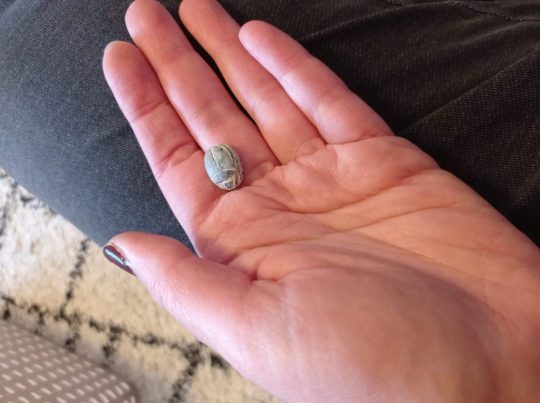
Spitzer contacted the Israel Antiquities Authority, and Omer Shalev, director of the organization’s Jerusalem Education Center, traveled to the school that same day and presented Amalia with a certificate of appreciate.
The scarab seal is a talisman in the shape of a dung beetle, an animal that was sacred to the ancient Egyptians and served as a symbol of new life. Such scarab amulets found in modern-day Israel indicate an Egyptian presence there some 3,500 years ago. The amulet bears the name of the sun god Amun-Ra, one of the great deities in the Egyptian pantheon during the New Kingdom (16th to 11th centuries B.C.E.). Five scarabs inscribed with his name had already been found at Tel Azekah.
“Many people have antiquities in their homes that came into their possession under different circumstances: some were collected in the field in the course of agricultural work or walking and others were inherited,” Eli Escusido, Antiquities Authority director stated in a press release published on the organization’s Facebook page. “Many of these people are unaware that by law they have to report the discovery of antiquities as they are legally public historical treasures.”
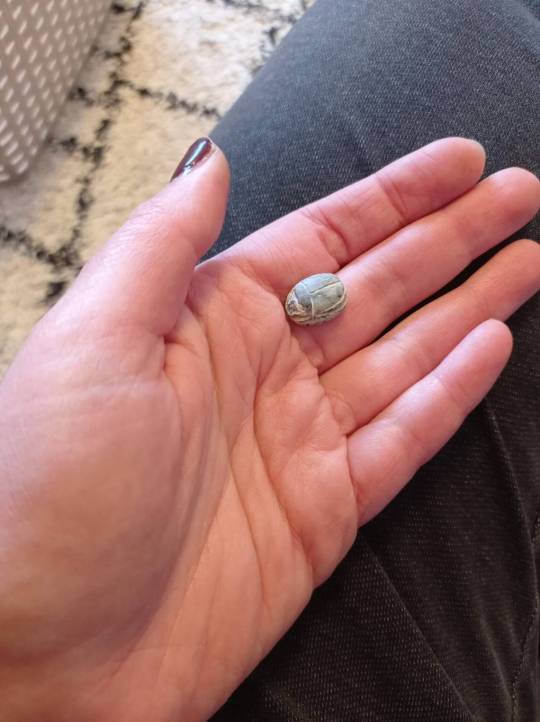

#Israeli First-Grader Finds a 3500-Year-Old Egyptian Amulet on a School Trip#Efrat Israel#Tel Azekah#Amalia Riverkin#scarab#scarab seal#ancient artifacts#archeology#archeolgst#history#history news#ancient history#ancient culture#ancient civilizations#ancient israel#ancient art
38 notes
·
View notes
Text
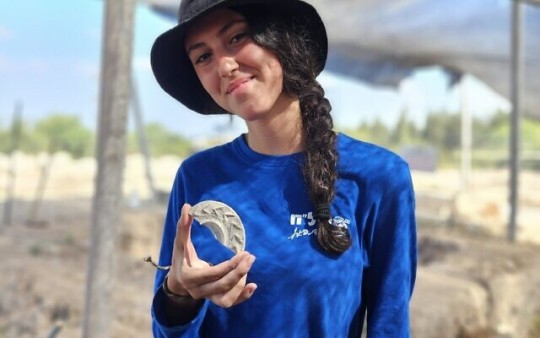
Byzantine ‘Magical Mirror’ Discovered in Israel
The 'magical mirror' was used to protect its owner against evil spirits, according to Israel Antiquities Authority.
A 17-year-old Israeli youth leader discovered an ancient “magical mirror” in an archaeological excavation in northern Israel.
Aviv Weizman from Kiryat Motskin near Haifa, joined an archaeological excavation at the ancient site of Usha, under the supervision of Israel Antiquities Authority, where she found the 1,500-year-old “magical mirror.”
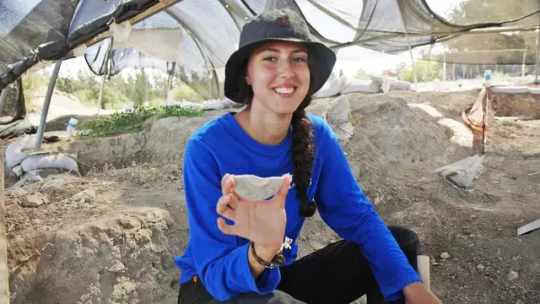
According to Navit Popovitch, Israel Antiquities Authority Curator of the classical Periods, the fragment is part of a “magical mirror” from the Byzantine period, the 4 th –6 th centuries CE.
"A glass mirror, for protection against the Evil Eye was placed in the middle of the plaque: the idea was that the evil spirit, such as a demon, who looked in the mirror, would see his own reflection, and this would protect the owner of the mirror,” Popovitch said.
“Similar mirror plaques have been found in the past as funerary gifts in tombs, in order to protect the deceased in their journey to the world to come,” Popovitch added.
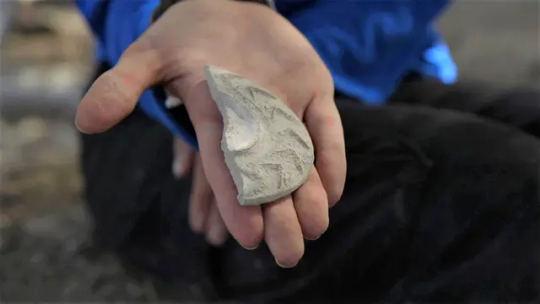
Eli Escusido, Director of the Israel Antiquities Authority added that the young leaders, who were on a week-long trek from Mount Meron to Mount Hermon in which they joined archaeological excavations along the route, discovered “additional finds”, such as including pottery jars, coins, decorated stone fragments, and even a a water aqueduct.
“History, usually taught in the classroom, comes to life from the ground. A pupil who uncovers a find in the course of an excavation will never forget the experience. There is no better way to attach the youth to the country and the heritage,” Escusido said.
According to Saar Ganor, coordinator of the project on behalf of the Israel Antiquities Authority, Weizman’s find “embellishes the two-way contribution of the cooperation between the Israel Antiquities Authority and the Ministry of Education Shelah Project: at the same time, uncovering the country’s past, and also providing the youth with a personal empowering experience, connecting them to their roots.”
By JOTAM CONFINO.

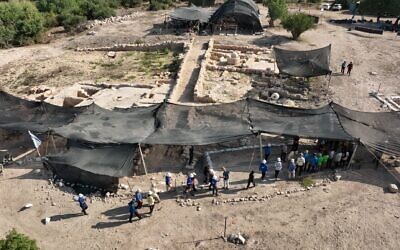
#Byzantine ‘Magical Mirror’ Discovered in Israel#ancient site of Usha#ancient artifacts#archeology#archeolgst#history#history news#ancient history#ancient culture#ancient civilizations#ancient israel
23 notes
·
View notes
Text



Police Seize Bricks Imprinted With The 10th Roman Legion Symbols in Israel
The Legio X Fretensis “Tenth legion of the Strait”, was a legion of the Imperial Roman army formed around 41/40 BC. The legion was centrally involved in the Great Jewish Revolt (AD 66–73), the first of three major rebellions by the Jews against the Roman Empire.
By around AD 70, the majority of Roman rule had been reinstated in Judea, with the exception of a few fortresses and the significant city of Jerusalem. The Legio X Fretensis, joined by the V Macedonica, XII Fulminata, and XV Apollinaris legions, lay siege to the city, and after several battles, Jerusalem and the Second Temple was destroyed.
According to contemporary historian, Titus Flavius Josephus, “Jerusalem…was so thoroughly razed to the ground by those that demolished it to its foundations, that nothing was left that could ever persuade visitors that it had once been a place of habitation.”


An operation by police in the Beit Hanina neighbourhood in East Jerusalem has led to the discovery of several cartons in a car trunk containing the pavement bricks. The bricks were likely part of a public building such as a bath house, which has since been looted in modern times for sale in the illegal antiquities trade.
The bricks date from roughly 2,000-years-ago and show the stamp of the Legio X Fretensis from when the legion built a military camp after Jerusalem’s destruction.


Amir Ganor, Director of the Theft Prevention Unit at the Israel Antiquities Authority, said: ” After the uprising, soldiers of the legion settled in the greater Jerusalem area where they constructed workshops to make bricks. The seals of the legion – “LXF” – were imprinted on them to mark the movements of the legion’s units throughout the country. The bulk of the distribution of bricks was identified in the Jerusalem area and in the Roman colony built on its ruins – ‘Aelia Capitolina’.”
Eli Escusido, Director of the Israel Antiquities Authority: “Discovering ancient bricks in the trunk of a car with fresh dirt and being displaced is heart-breaking. If archaeologists had found the bricks on the site itself, we would have been able to gain information for archaeological research as well as add another archaeological site on the historical map of our country. Now, we are left to try and find out through investigative operations where the bricks were dismantled and looted from.”




#Police Seize Bricks Imprinted With The 10th Roman Legion Symbols in Israel#The Legio X Fretensis#10th Roman Legion#ancient artifacts#archeology#archeolgst#history#history news#ancient history#ancient culture#ancient civilizations#roman history#roman empire#roman legion
29 notes
·
View notes
Photo

Looted Rare Coin From Last Hasmonean king Seized in Israel
IAA says coins minted under Antigonus Mattathias II rarest from period; dozens of other ancient coins from Roman to Muslim periods recovered in search of East Jerusalem home.
Police recovered dozens of ancient coins that were allegedly illegally excavated — among them a rare coin from the time of the last Hasmonean king of Judea over 2,000 years ago — during a search in East Jerusalem overnight, the Israel Antiquities Authority said Wednesday.
The currency was recovered from the suspect’s home in the Silwan neighborhood and includes bronze coins ranging from the Roman period until the Muslim period. The IAA said in a statement that coins from the reign of Antigonus Mattathias II (40 BCE – 37 BCE) are the rarest finds among those minted from the Hasmonean period.
Police questioned a man in his 30s, suspected of robbing the artifacts — likely by searching for them with a metal detector around Jerusalem — illegal possession of artifacts, and attempting to sell the items.
IAA Director Eli Escusido said that finding the coins at their original site would have been more useful to their study.
“The removal of the coin from its archaeological site harms the ability to understand our historical puzzle,” he said.
Gabriela Bichovsky, a coin expert at the IAA, said a cornucopia is displayed on the coin, with a Hebrew inscription reading, “Mattia Kohen Gadol,” a reference to the Hasmonean king as a member of the Jewish priestly class. The opposite side of the coin was minted with a Greek inscription surrounded by a wreath, she said.
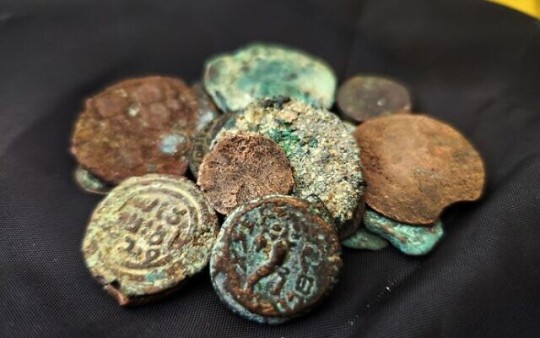
“Mattathias minted bronze coins in three denominations: large, medium, and small. The coin that was recovered is of the medium denomination and is rarer than the large, on which a pair of cornucopias appear instead of one,” Bichovsky added.
She further explained that the methods used were unique to Mattathias.
Before being stamped with their designs, “the tokens were first cast in a double limestone mold, creating a thickening coin that looks as if two were stuck together,” she stated.
“It’s very difficult to find currency from Antigonos where you can see the models in their entirety on the faces of the coin. Among the currencies of the Hasmonean period, the coins of Antigonus Mattathias II are the rarest.”


#Looted Rare Coin From Last Hasmonean king Seized in Israel#Antigonus Mattathias II#coins#collectable coins#looted#stolen#hasmonean period#ancient artifacts#archeology#archeolgst#history#history news#ancient history#ancient culture#ancient civilizations#ancient israel
33 notes
·
View notes
Photo

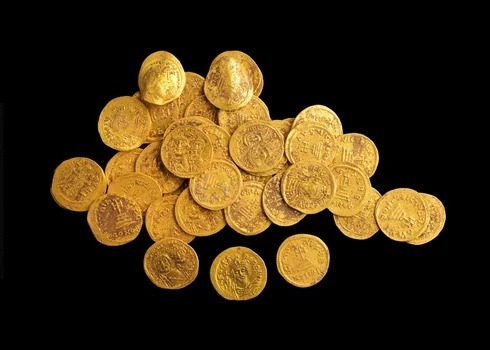
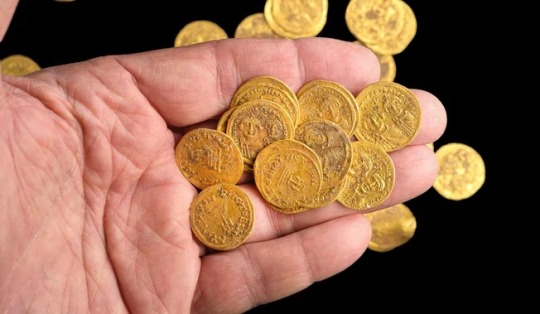
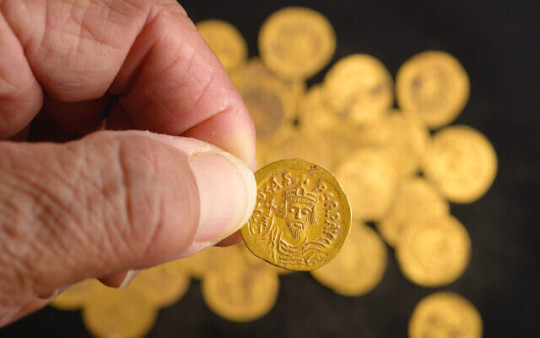

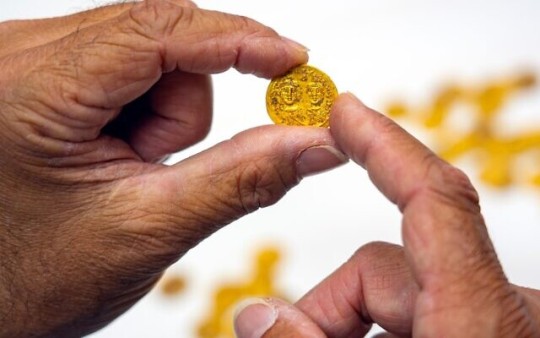



An Ancient Hoard of 44 Byzantine Gold Coins Discovered in Israel
A hidden cache of 44 gold coins dating from the Muslim conquest of Jerusalem was recently found during an archaeological excavation at the site of the ancient city of Banias, the Israel Antiquities Authority (IAA) revealed on Monday.
Several of the coins were dated to the reigns of Emperor Phocas (602–610) and Emperor Heraclius (610-641), the latter of which overlapped with the Muslim conquest of Byzantine Palestine in 635.
“The coin hoard, weighing about 170 grams … reflects a specific moment in time, when we can imagine the owner concealing his fortune in the threat of war, hoping to return one day to retrieve his property. In retrospect, we know that he was less fortunate,” said Yoav Lerer, who directed the excavation on behalf of the IAA.
Banias, which is located within the Hermon River nature reserve, was first established by Canaanites and reached its peak in the Early Roman period, when Herod the Great and his son Philip II entirely rebuilt the city and named it Caesarea Philippi, in honor of Roman Emperor Augustus.
According to Christian tradition, Banias is where Peter the Apostle recognized Jesus as the messiah and thereafter received the keys to the kingdom of heaven, as recounted in Matthew 16:18.
Eli Escusido, director of the Israel Antiquities Authority, said of the discovery: “The coin hoard is an extremely significant archaeological find as it dates to an important transitional period in the history of the city of Banias and the entire region of the Levant. The Israel Antiquities Authority, together with the National Parks Authority, will work together to exhibit the treasure to the public.
#A Ancient Hoard of 44 Byzantine Gold Coins Discovered in Israel#coins#collectable coins#gold coins#ancient coins#ancient artifacts#archeology#archeolgst#history#history news#ancient history#ancient culture#ancient civilizations#emperor phocas#emperor heraclius#emperor augustus#banias
221 notes
·
View notes